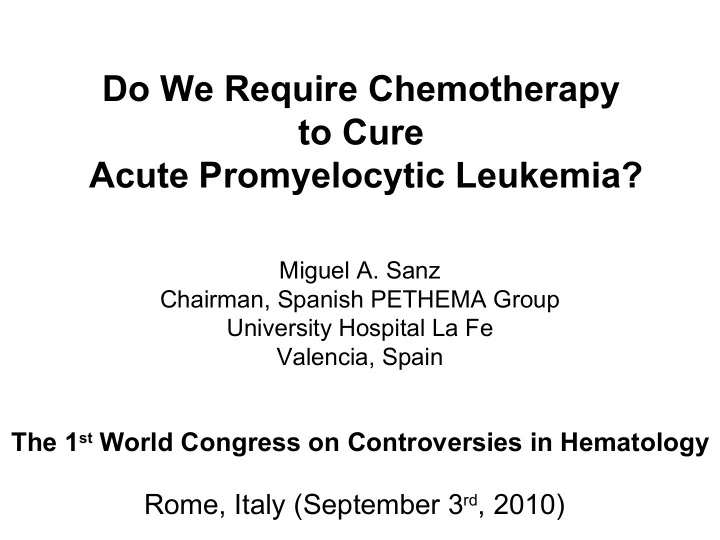

Do We Require Chemotherapy to Cure Acute Promyelocytic Leukemia? Miguel A. Sanz Chairman, Spanish PETHEMA Group University Hospital La Fe Valencia, Spain The 1 st World Congress on Controversies in Hematology Rome, Italy (September 3 rd , 2010)
Curability of APL without Chemotherapy (or with minimal use of chemotherapy) Long-lasting remissions have been reported with: Liposomal ATRA alone (MDACC) Arsenic trioxide ± ATRA (China, Iran, India, MDACC) ATRA followed by maintenance chemotherapy
Do We Require Chemotherapy to Cure Acute Promyelocytic Leukemia? No, but… is this the appropriate question?
Do We Require Chemotherapy to Achieve a Higher Cure Rate in Acute Promyelocytic Leukemia? Yes
Current Standard Approach ATRA + anthracycline-based chemotherapy The available data do not suggest any advantage of ATO when compared with chemotherapy
The use of ATO should be restricted to: ˗ Patients unfit for chemotherapy ˗ Clinical trials
Is Arsenic Trioxide a Real Alternative to Chemotherapy? ATO should be evaluated in proper comparisons with the standard approach in terms of: – Efficacy – Safety – Cost-effectiveness The challenge is to demonstrate a significant superiority in terms of efficacy and/or safety.
Direct Costs of Antileukemic Drugs for a Standard Patient with APL Patient: 1.8 m 2 (70 kg) 50000 Cost in Euros 40000 30000 20000 10000 0 C C C T I n o o o o d t n n n u a s s s c l o o o t i l l l o 1 2 3 n ATRA Idarubicin ATO
Induction Therapy with AIDA Causes of failure (n = 739) Room for improvement Other (0.3%) RAS (1.3%) CR Infection (2.3%) 91% Death 9% Hemorrhage (5%) Virtual absence of resistance De la Serna et al . Blood 2008
Post-remission Outcome with AIDA Causes of failure Room for improvement • Death in CR: < 1% • Relapse (CIR at 5 years): 7% ˗ Low risk: 4% (20% of APL patients) CR 91% ˗ Intermediate risk: 6% ˗ High risk: 11% (25% of APL patients) ˗ Therapy-related AL/MDS (CI at 6 years): 2.2% ˗ Late cardiotoxicity: ? How many patients are needed to demonstrate a significant benefit of these outcomes? Sanz et al . Blood 2010 Montesinos et al . J Clin Oncol 2010
Are Treatment Options for APL Mutually Exclusive?
Ongoing Studies Exploring the Replacement of Chemotherapy by ATO • GIMEMA trial – WBC ≤10x10 9 /L: standard approach (AIDA) vs. ATO - based approach (MDACC) – WBC >10x10 9 /L: standard approach • BNCRI trial – standard approach (AIDA) vs. ATO -based approach (MDACC)
Are Treatment Options for APL Mutually Exclusive? They are complementary options
Studies Exploring the Complementary Use of Chemotherapy and ATO • French-Belgian-Swiss Trial (ongoing) – WBC ≤10x10 9 /L: ATRA vs. Ara-C vs. ATO in consolidation – WBC >10x10 9 /L: Ara-C vs. Ara-C + ATO in consolidation • PETHEMA/HOVON planned trial – Insert 2 cycles of ATO + ATRA in a standard consolidation
Recommend
More recommend